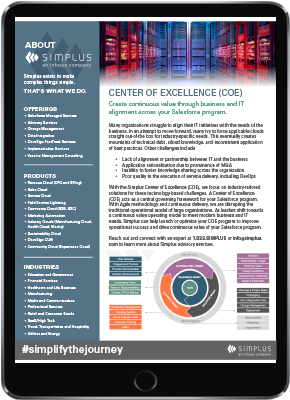Business Transformation Services
Plan and prepare your vision
Strategize for your transformation future with the best. Our advisory experts are leaders in guiding large-scale projects from day one with focused analysis, design, and discovery sessions. We take the time to understand your pain points and goals and lay out a blueprint to achieve them.

ONE-SHEET
Center of Excellence (CoE) Offering
A Center of Excellence (COE) acts as a central governing framework for your Salesforce program. With Agile methodology and continuous delivery, we are disrupting the traditional operational model of large organizations.
Innovate with
Business Transformation Services
Modernize with
Business Transformation Services
Start strategizing with Simplus.
Speak with one of our certified Salesforce experts today.








